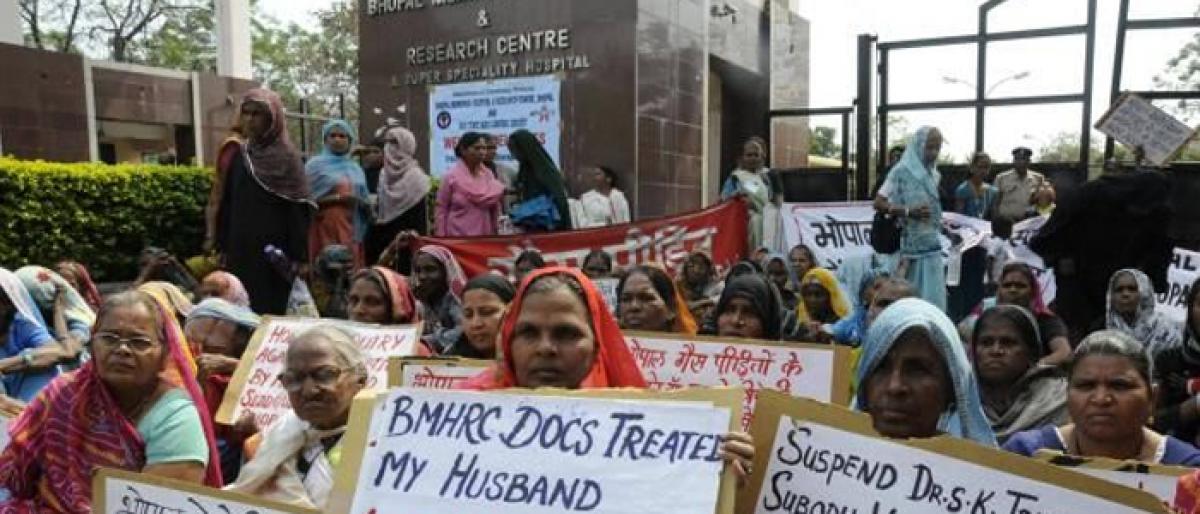Live
- Man held for posting obscene photos
- iOS 18.2: Apple’s New Battery Intelligence Feature Coming Soon
- PM Modi’s ‘Bharat 6G Vision’ poised to get another booster
- Food stalls raided
- Garena Free Fire MAX Redeem Codes for November 8, 2024
- IT Raids on Ex-MLA Grandhi Srinivas Continue for Third Day in Bhimavaram
- Jharmunda-Boudh section gets CRS nod
- Upcoming Telugu OTT Releases This Week: Devara, Meiyazhagan, Kali
- Trapped leopard rescued
- Vijayawada: Seven police officers get IPS rank
Just In
Poor Indians turning guinea pigs for greedy pharmaceutical firms


We are notoriously corrupt People are poor and ignorant also They do not even try to know Multinational companies MNCs are clever Doctors are either compelled to be silent or actively involved As the main motive of the young doctors is to recover the cost of their education and make quick money they simply toeing the ambitious and unethical profit maximization plans of corporate businessm
We are notoriously corrupt! People are poor and ignorant also. They do not even try to know. Multinational companies (MNCs) are clever. Doctors are either compelled to be silent or actively involved. As the main motive of the young doctors is to recover the cost of their education and make quick money they simply toeing the ambitious and unethical profit maximization plans of corporate businessmen.
The silence or criminality of doctors is an important facilitating factor behind converting Indian poor into gullible victims of injurious clinical trials. Human life has no value for them. They do not mind causing slow deaths. They do not intend killing a specific person, but do not care if some poor is either severely injured with diseases or even succumbs. Deliberately the pharma companies do not disclose what and why they are trying and consequences of clinical tests.
The consent of the people is extracted without full disclosure of all relevant facts about clinical trials. Even if the people die of those trials, none cares, neither the government, nor the companies. The clever corporate companies secure permits from corrupt officials of the state and execute dubious trials with silent doctors.
They made India rendezvous for clinical trials and Indians, the gullible guinea pigs! There are no strong regulatory laws. No disclosure is insisted. In the absence of factual disclosure informed consent is impossible.
Colin Gonsalves, the founder of the Human Rights Law Network, says in a report that on account of all clinical trials conducted by various pharmaceutical companies, nearly 2,800 patients were said to have died between 2005 and 2012 in India. A parliamentary panel report found all parties involved of gross ethical violations — the ministry, Drugs Controller General of India (DCGI), Indian Council of Medical Research (ICMR) and those who conducted the clinical trials.
The Drugs and the Cosmetics Act was amended in 2005 only to permit multinational pharmaceutical companies to conduct tests called Phase II clinical trials on Indians in India. This is for the first time that such permission was given. Those companies breach their duty to provide needed reports from their countries.
Colin Gonslaves says: “…clinical trials in India have been accompanied by large-scale criminality as doctors, officials and pharmaceutical companies understand well enough that India is a cesspool of corruption where clearances can be had for a pittance.
While there have been many cases since, the underbelly of India’s clinical trial industry came to the spotlight in 2005 when 3,300 patients were subjected to 90 clinical trials that followed no protocols at a hospital in Indore, Madhya Pradesh. In American law, such violations automatically attract the criminal charge of battery. In India, the poor don’t count at all”.
Non-disclosure angle is the worrying factor as the subjects/victims of these tests are not fully informed. Once they concede to the tests, no individual has a right to withdraw. There is no comprehensive medical insurance or meticulous monitoring after the drug was administered on them.
These are the serious crimes being perpetuated against them. They die. But nothing happens. None notices. Media does not bother, nor highlight. Mostly corporate media is paid to be friendly with corporate pharmaceuticals. For political parties, it is no issue.
Gonsalves pointed out that 16,000 tribal girls in Andhra Pradesh and Gujarat were used for these trials without consent from the girls’ parents. $3.6 million worth human papilomavirus (HPV) vaccines were tested on these poor girls. There were allegations of adverse effects.
The 72nd Parliamentary Standing Committee Report, in a scathing indictment of India’s then booming clinical trial industry, implicated the DCGI for licensing the vaccines without adequate research on safety and efficacy; the Health Ministry for not questioning violations in the licensing process; the ICMR for promoting a drug even before it was approved and the NGO for setting up a trial without following basic protocol.
The parliamentary committee found commercial interests were influencing government policy, and that authorities were “overenthusiastic to act as willing facilitators to the machinations” of foreign institutions.
The committee recommended that henceforth, trials ought to be conducted only in the 330 medical colleges that have emergency facilities. It also sought — among other things — an investigation into the illegal approval of drugs and of doctors who submitted “ghost” letters recommending drugs for approval.
A book published by National Academy of Sciences Safety Testing, in 2004 wrote: Laboratory animals are not only crucial in understanding diseases; they are also essential in evaluating the safety of drugs, vaccines, food additives, household products, workplace chemicals, cosmetics, water and air pollutants, and many other substances.
The Food and Drug Administration (FDA) oversees this process for drug, vaccine, food additive, and cosmetic safety testing. Other agencies like the Consumer Product Safety Commission, the Environmental Protection Agency, and the Occupational Safety and Health Administration regulate other types of testing .
The book further noted: In 1933, more than a dozen women were blinded and one woman died from using a permanent mascara called Lash Lure. Lash Lure contained p-phenylenediamine, an untested chemical. At the time, there were no regulations to ensure the safety of products.
Explaining the need for drug safety testing with higher standards the book narrated another tragedy: A few years after the Lash Lure incident, another tragedy involving untested products occurred. A drug company in Tennessee decided to develop a liquid form of a sulfa drug (antibacterial) that would appeal to children. This drug company took a well-tested sulfa drug, mixed it with a sweet-tasting liquid that children would like, and sold it as “Elixir Sulfanilamide.”
Unfortunately, the drug company did not test the safety of Elixir Sulfanilamide before putting it on store shelves. The pleasant-tasting liquid in Elixir Sulfanilamide contained ethylene glycol, a sweet-tasting poison that is the main ingredient in antifreeze. Ethylene glycol poisoning causes the kidneys to fail so that toxins and fluid are not excreted from the body.
Eventually, the amount of toxin build-up is so great that it over-whelms the body and causes death. Elixir Sulfanilamide killed 107 people, mostly children, before it was pulled from store shelves. Source: https://www.ncbi.nlm.nih.gov/books/NBK24645/
There is a lack of awareness about the guidelines for standardized and transparent reporting of biomedical research, among the medical professionals. To ensure transparency in bio medical research, several guidelines are established world over, such as:
1. The “Enhancing the Quality And Transparency of health Research” (EQUATOR) network has published more than 350 guidelines for Health Research Reporting;
2. With respect to generic formats of study designs, the common ones are the “Consolidated Standards for Reporting Trials” (CONSORT) for randomized trials;
3. “Strengthening the Reporting of Observational Studies in Epidemiology (STROBE)” for observational studies;
4. “Standards for Reporting of Diagnostic” (STARD) for diagnostic studies;
5. “Preferred Reporting Items for Systematic Reviews and Meta-Analyses” (PRISMA) for systematic reviews and meta-analyses; and
6.“Standard Protocol Items: Recommendations for Interventional Trials” (SPIRIT) for defining protocol items for clinical trials;
7. More and more specialised guidelines have been developed such as CONSORT non-inferiority for reporting of non-inferiority and equivalence trials;
8. The RECORD statement for the reporting of studies conducted using observational routinely collected health data , and so on;
9. Apart from these, there are other guidelines too that deserve a mention such as “Statistical Analyses and Methods in the Published Literature” or SAMPL guidelines for reporting statistical analyses;
10. “Strengthening Analytical Thinking for Observational Studies” (STRATOS) for reporting observational studies.

© 2024 Hyderabad Media House Limited/The Hans India. All rights reserved. Powered by hocalwire.com






